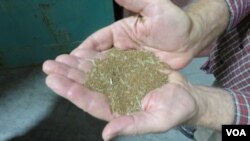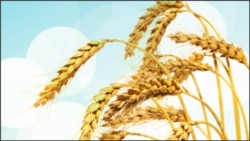Many cultures around the world have a grain that is not grown or even known outside its home area.
Quinoa is from South America. Amaranth fed the Aztecs in Central America.
Now, an ancient grain from Ethiopia, teff, is appearing on grocery shelves in America. Teff has been an important part of the Ethiopian diet for thousands of years. Like oat, rice and wheat, it is a cereal grass. Teff is known for its small grain. It is used mainly to make flour.
Teff has a mild, nutty or earthy taste. Teff flour is the key ingredient for the well-known, spongy flatbread found in Ethiopian restaurants.
Wayne Carlson learned about teff while doing public health work in Africa in the mid-1970s.
“I came to know teff because I was eating it all the time and hosted by teff farmers."
In the late 70s, Carlson returned to the U.S., married and settled in southwest Idaho. Then he came up with an idea to introduce teff grass to North America in his home state.
"Geologically, it is very similar to Ethiopia. Ethiopia is placed on the East African Rift Valley, which is very much like the Snake River Plain."
Wayne and his wife Elisabeth are not farmers, nor do they want to be. So they convinced actual farmers in Idaho, Oregon and Nevada to grow teff on contract for them. The Carlsons milled it themselves.
Until last year though, there was not a single Ethiopian restaurant or bakery in the entire state of Idaho to sell the milled flour to.
"The way we started was Wayne went through the Washington, D.C., telephone book and looked for the names that were Ethiopian."
And that is how the business slowly grew for several decades, serving the Ethiopian and Eritrean immigrant community in the U.S.
Over time, the Teff Company has outgrown four different mills. The first was a little stone grinder in the Carlsons' basement. Now, they occupy a remodeled brewery complex in Nampa, Idaho.
The Carlsons say the teff flour coming off the mill could end up in an upscale natural foods store or commercial bakery.
A teff explosion
Sales of alternatives to modern wheat are growing quickly each year, says an industry trade group.
Rich Roseberg is a food researcher at Oregon State University.
He says teff production has exploded over the past decade in the U.S. The grain has gone from 1,200 hectares in 2003 to more than 40,000 nationally by 2010. He says most teff grown in the U.S. is fed to farm animals.
"It's a good livestock forage in general, but it does seem like horses have a preference for it in some informal taste tests where we compared teff with other common grasses."
In Idaho, however, where the Carlsons are based, Roseberg believes more of the teff production is for human food. Teff contains lots of calcium, iron, protein and fiber. Roseberg credits Wayne Carlson for being ahead of his time.
"He recognized the value of teff -- at least for teff grain -- long before any of the rest of us did."
The University of Nevada, Reno is leading a project to breed "improved" varieties of teff. The aim is to make teff more productive and able to survive drought. Nevada scientists are trying to prepare for severe growing conditions due to global warming.
One advertisement for the Teff Company says, "Move over quinoa, there's a new grain in town." The new grain is really an ancient one, but Wayne Carlson does not like the term "ancient grains" to describe teff.
"Teff was never really a relic. It was never bypassed by history. Teff has always been the mainstay crop for millions and millions of people. It's just that they were geographically isolated in northeast Africa. So all we've done is said to the rest of the world, 'Hey look, there's this really good stuff there. Why don't you incorporate it in your diet?'"
And the rest of the world is doing just that.
I’m Marsha James.
Do you or someone you know use teff when preparing meals or baking? Let us know in the comments section.
Tom Banse reported on this story from Nampa, Idaho. Marsha James adapted his report for Learning English. Kelly Jean Kelly was the editor.
______________________________________________________________
Words in This Story
mill – n. a building with machinery for grinding grain into flour
forage – n. grasses and other plants that are eaten by animals
relic – n. something that is from a past time, place, culture
bypass – v. to avoid or ignore
mainstay – n. a very important part of something
upscale – adj. appealing to people who have a lot of money








